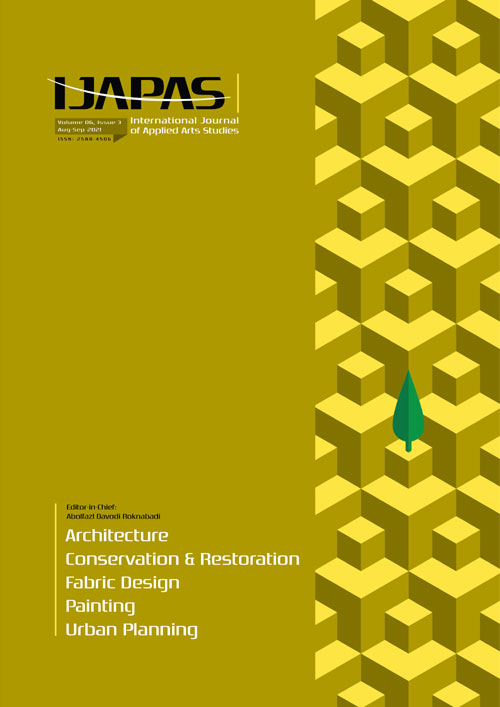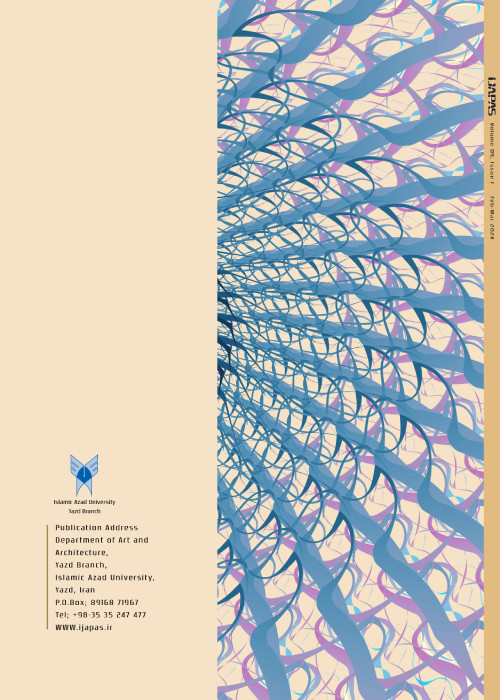فهرست مطالب

International Journal of Applied Arts Studies
Volume:6 Issue: 3, Aug-Sep 2021
- تاریخ انتشار: 1400/11/19
- تعداد عناوین: 6
-
Pages 7-20
Knowledge has long been in the field of human knowledge. In the evolutionary history of science, many theories and hypotheses have always been proposed and proven.This category reflects the fundamentalchanges in the mannerof thinking in human knowledge. In the contemporary era, knowledge facesmore complex issues.Therefore, achieving growth and production in any field by using new methods based on looking to the future is one of the pillars of human knowledge.In the field of architectural design process studies, the growth and development of creativity, that is, how ideas arise and develop in the mind, is one of the topics. Creative results in the field of architecture can be the result of changing the problemcomponents according to the existing contradictions recognition in the field of architectural design process.Since the design process involves the emergence, evolution, metamorphosis of ideas, and the formation of concepts, oneof the topics inthe designprocess is the conceptual transformation.Conceptual traditionby changing the way of thinking, offers creative solutions to improve the way of knowing and solving the optimal problem.The role of conceptual traditionin the development of the architectural design process is by changing the components of the design problem. On the other hand, competitiveness is the basis for the growth and promotion of the field of architectural design.Therefore, achieving a meaningful relationship between conceptual traditionand competitiveness in architectural design, to increase creativity in the field of architectural design is research necessity.The research method has been done “deductive reasoning”and using “analytical-descriptive”measures, with a quantitative and qualitative approach.Field studieshas been carried outusing questionnaire. To validate the data measurement, standard evaluation tools and theories of the Delphi expert community have been cited.Preliminary data extractedfrom the first stage in eight architectural projects were evaluated through Delphi and related factors were extracted.Finally, using pls software and regression test based on the extracted data, the research hypotheses were proved.
Keywords: Tradition, Problem Components, Competitiveness, Creativity, Architectural Design -
Pages 21-30
The lifespan of Kalpuregan’spottery goes back to 3,000 BC and is probably one of the few areas in the country where the same traditional methods of designing and making pottery are done there now. Recognition of indigenous phenomena is possible by understanding human activities in the environment around them. Laboratory studies for analyzing pre-historic pottery in Iran willgive us a betterunderstandingof the production and distribution process. In the meantime, pottery items in Kalpuregan come from technology and firing clay. Clay is abundantly found on the surface of the earth. So far, no reports have been published on the recognition ofelements thatform containers or potteries in the Kalpuregan, district of Saravan. Most of researches have been done on the motifs and ways ofmaking this pottery. The aim of this study was to identify Kalpuregan pottery using petrographic test. The results showed that Kalpuregan soil is secondary clay.These types of claysinclude various types such as ballclay, stoneware, red clays, marl, bentonite and refractory clay. The components of pottery comprise the following three major categories: clays, fillers, and fluxes. Clay has other elements such as titanium oxide, potassium oxide, sodium oxide, magnesium oxide, iron oxide and calcium oxide, thepercentage of which is different depending on the type of soil. In the process of research, after the petrographic examination, it was found that most of the elements of the clay for pottery in Kalpuregan are Quartz minerals, which are seen as phenocryst and polycrystalline. This type of mineral makes up 20% of the sample volume. In the course of research on the type of fire inKalpuregan pottery kilns, it was found that the color change of pottery after firing is due to the temperature conditions of pottery kilns in this area.
Keywords: Pottery, Kalpuregan, Saravan, Petrography, Structural Analysis, Instrumental Analysis* Corresponding author. Tel: +98-9394934770.E-mail address:takshahrzad@yahoo.com -
Pages 31-38
Handicrafts are part of the national arts and crafts of Iran, which in addition to economic production aspects, reflects national culture and values, as well as creativity and philosophical insights andartistic tastes of ethnic groups living in any part of the country. In other words, handicrafts and traditional indigenous arts related to handicrafts, in addition to the economic aspect, express the social history of societies and represent the ethnic cultures and arts of the Iranian people. For many people, the concept of handicrafts and what the handicrafts are called, and where the artistic, cultural and economic values of this part of national activity lie, may not be clear, but it is important to note that today, in many countries of the world, even in the most industrialized countries, the economic activity of handicrafts is considered as a basic source for the production of goods, especially export goods, and an important means of creating employment, exports, and so on. In this article, a review of handicrafts and clothing of the people of Sistan and Baluchistan has been studied and the handicrafts and clothing of this people have been studied.
Keywords: Handicrafts, TraditionalWeaving, Sistan, Baluchistan, Needlework -
Pages 39-46
The prevalence of various diseases caused by pathogenic bacteria and their resistance to antibiotics has forced researchers to search for healthy and safe methods to produce products suitable for human well-beingwith the advent of nanotechnology in the present century,nanomaterials such as silver,gold,zinc,copper and titanium dioxide are used as antimicrobial agents.In this study,the antimicrobial efficacy of cotton samples in in reducing two common strains of Gram-positive Staphylococcus aureus,source of eye,skin,bone and joint infections and Gram-negative Escherichia coli,origin of urinary tract infections,nosocomial and blood infections using zinc nanoparticles and harmaline,has been examined for use in children’s doll clothes.Smallamounts of antimicrobial test ofthe samples indicate that in the treated samples the average percentage of bacterial reductionfor Gram-positive bacterium Staphylococcusaureus was %96 and Gram-negative Escherichia coli %99.Also,in the doll costume design section,an attempt has been made to be inspired by one of the mythological symbols of Iran (Simorgh)and the designs should be based on it.The research method in this article is descriptive based on the nature,because;there was no intrusion into the information obtained and the results were reported realistically.Thisresearch is based on the experimental method,because;alaboratory process is required to prepare the fabric with the desired properties.
Keywords: Hamaline, Fabric Design, Costume Design, Doll -
Pages 47-58
The present study explores the life and work of Hossein Aqajani-Esfahaniwith a descriptive and analytical approach. The aim of this study was to review the works and cultural services of an artist, who has a significant positionin the field of restoration of the monuments and buildings, and on the other hand, in the domain of academiceducation, as well as in the domain of management in cultural position, his role is highly considerable. But unfortunately, based on the availableresources, no research yet has been conducted about this artist.The approach of the research in the analysis of the works of this artist was based on statistical population, consisted of various works in the field of restoration.The result of the research is that Hussein Aghajani-Esfahani in his restoration projects tried to consider historical authenticity and stylistic features of the works with his extensive knowledge and command of the field of restoration, and in developing this attitude he would have a determining role. Documentation and following the executive authenticity in reconstruction is one of theimportant points of his works of restoration in various fields.
Keywords: Restoration, Iranian Painting, Mural, Hossein Aghajani-Esfahani -
Pages 59-77
Fractal has been considered asan optimized structure of nature and an effective tool for depicting spatial complexity. Acity can be deemed as a fractal system with self-similarity, andare,therefore, ideal candidates for fractal analysis. Recent decadeshave witnessed great strides in research on fractal cities invarious aspects of urban forms and structuresas well asurban development dynamics. Considering the deep and wide-ranging applications of fractal theory in explaining local and spatial complexities, this study aimed atconducting a systematic review and content analysis of research conducted on fractal in order to pinpoint practical and theoretical frameworks they can provide to specialists in the fields of geography and urban planning. To this end, a systematic review was carried outin three general stages ofstudy selection, evaluation,and synthesisof findings. Resultsshowedthat developingand emergingconcepts in theoretical and experimental studies, which has soughtto explaintherolesandapplications of fractal theoryin research andsimulations of the builtenvironmentcouldbe classifiedin 10 areasofpsychology, architecture, urban design, urban formand structure, urban boundaryshape, land use, urban traffic, urban growth modeling, urban hierarchy,and benefits of fractals. Studies related to urban formand structure (N=37)accountedforthe largest share of studies. In addition, key methodsleading to the development of fractal studies in the existingliterature were use of fractal dimension and Hausdorffdimension (34%), boundarydimension (24%), and network or box-counting dimension (14%) followed bypower law (PL) distributions, power laws, andpower-scale law(7%).
Keywords: Fractal Theory, Systematic Review, Content Analysis, Measures, MeasurementMethod, Urban Planning


